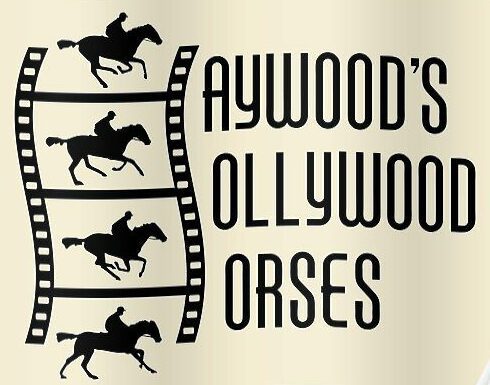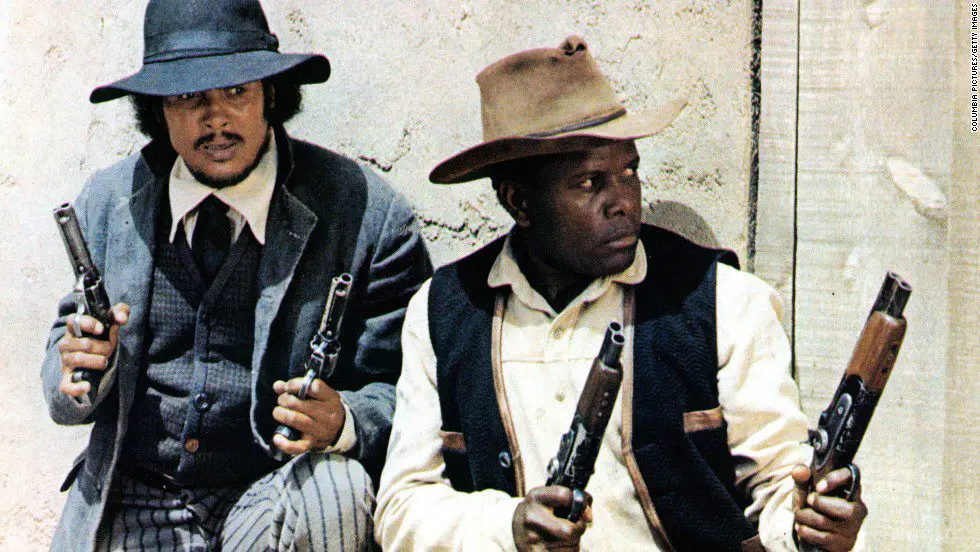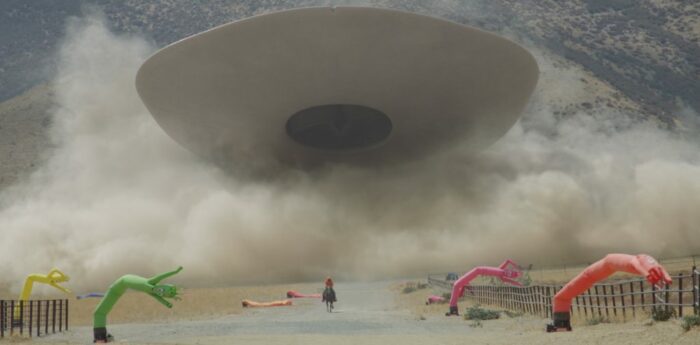In white text against a black screen, these words open Jordan Peele’s Nope, the director’s third feature film:
I will cast abominable filth upon you, make you vile, and make you a spectacle.
—Nahum 3:6
For biblical context, the oracle Nahum utters this prophecy as celebration of the of the destruction of the city Nineveh. Nineveh, which existed as the capital city of the Assyrian Empire, was an empire like many who conquered and colonized the people already living there. The audience is soon introduced to the conquer and colonizer of the film, a massive cylindrical anomaly in the sky that doesn’t look dissimilar to the cowboy hats adorned by several the characters in the film, an anomaly Not Of Planet Earth.
OJ Haywood (Daniel Kaluuya) is left to manage his family’s business, and is struggling to do so, six months after the mysterious death of his father Otis (Keith David) who was killed while sitting atop his horse by debris falling from the sky. Haywood Hollywood Horses is the animal handling and training business left largely to the serious and stoic OJ, though not without the unique brand of help offered by his much more charismatic and convivial sister Emerald (Keke Palmer). The business’ trademark graphic is meant to bring attention and pay homage to the Black jockey mounted atop the black horse he is riding in what is commonly credited as being the first motion picture. It’s not by accident of course that the name of the filmmaker Eadweard Muybridge is known but the name of the Black jockey has been lost to history. This is the first instance of conquering and colonization highlighted by Peele.

Hollywood and the movie-making industry is just one of the elements Nope casts a critical eye on. Cinema as a whole, and certainly the three genres Peele uses to tell the story of Nope—western, sci-fi, and horror—are not thought of as places in which one can point to a Black influence or lineage. These are thought of as white spaces where John Waynes ride horses into sunsets, Matthew McConaugheys look for new planets to conquer, and Bruce Campbells run away from flesh-eating undead. It is by design of course that the influence of Black creators and actors has been systematically ignored, because it has produced this image of movies created by white people, using white people, and specifically for white people.
Just like the jockey’s name from the first ever film is unknown, so too is the rich history of the interracial and collaborative movement that embodied cinema at its genesis before its commodification by power and white elites. OJ’s office displays a poster of the 1972 western Buck and the Preacher starring two cinematic giants, Sidney Poitier, and Harry Belafonte, as a tribute to the places Black actors have already been that the general population thinks they don’t fit into. Film has effectively used the labor capital of Black people, swallowed their contribution, and spit them out.

The unidentified object hovering over the Haywood ranch does the same thing—comes out under the cloak of night, swallows everything that looks at it, and regurgitates that which it does not need or no longer wants. It is imperative in the year 2022 to recognize the similarities between this floating figure, this omniscient, always watching, ever ready force and social media and the influencer culture that so largely looms over our daily lives. If we analyze the trajectory of Jordan Peele’s burgeoning film career we can see his debut feature Get Out as a commentary on white supremacy’s ability to co-opt and control Black bodies, Us as a critique on class and culture, the collective fear the United States has toward the outsider, and wealth inequality, and now Nope not only as a scrutiny of the white power dynamic and the ways in which Black art has been documented in hollow and incomplete ways, but also how Black music and culture has been appropriated and controlled by white influencers in yet another system saturated by whiteness—social media.
Not one of the big three social media empires controlling what feels like the world today comes with a clear conscience. Mark Zuckerberg’s Facebook was born out of misogyny and elitism. Instagram was hardwired with its filters, an aspect of the site that the creator was unmoved to change and aimed to specifically highlight as it developed. It’s no wonder, of course, that insiders at Instagram, through their own internally conducted research have discovered that the creation of seemingly perfect faces and worlds consumed through the platform has led to a sharp rise in self-esteem issues, eating disorders, and suicides among its users. Finally, TikTok, the jovial short videos of dancing young people hide the sinister plan of those pulling the strings. Not only have various TikTok challenges promoted illegal activity and caused the deaths of those performing them, but it has come out, again through internal documents, that moderators were told by TikTok to suppress the content of those that they deemed too “ugly”, “poor”, “disabled”, or from “slums” in their popular “For You” algorithm.
Not only does TikTok have that strike against them, but the social media platform has also recognized and apologized for their part in suppressing material related to Black Lives Matter as well as acknowledging their role in the videos from white creators, much of which exist as direct copies of videos made by Black creators, being more highlighted and thus gaining more views and attention. White “content creators” have been featured on late night talk shows, performed during halftimes of NBA games, and been featured in commercials for products solely because they gained notoriety and popularity for doing dances that they didn’t create while not giving credit to the Black artists that did create them. Understood under the larger umbrella of the access afforded to white people and their unique ability to appropriate and then popularize Black culture without giving credit or recognizing that these stolen art forms are the result of Black creatives, social media exists as yet another mechanism that promised the potential to democratize access to a wider audience that has actually led to another means of marginalization.

While explaining his observations about the UFO to his sister, OJ describes it as territorial. We see someone who proclaims himself to be from TMZ illegally ride onto the Haywood ranch to film the UFO only to use his dying breath after he is struck down by it to make sure that his footage is passed on for views. The technician, Angel (Brandon Perea) who helped the Haywood’s set up security cameras to capture the apparition finds himself unable to abandon the spectacle and illegally taps into their feed to view it himself, then inserts himself onto the Haywood’s property and among their plans on how to deal with their UFO intruder.
Each of these plot points can be allegorically tied to social media and the influencers known for inhabiting that space. The white content creators have been historically territorial, akin to the historical territorialism of white “explorers” who have traveled to places already inhabited to steal what they found of use and leave behind entire populations to despair and destruction. These influencers have, like the UFO, sucked up the cultures of Blacks and other People of Color, spitting them aside, then ravenously looking for more “content” to continue passing off as their own with no credit given to creators to please the all-consuming eye of the white audience. They, like the TMZ reporter, must have their pages observed, forever reaching for an infinite number of subscriptions and more and more of the ever-important views. Like Angel, they cannot help themselves from watching the content of others and demanding to be a part of it in some way, even if that means interjecting themselves in a place they have been asked to leave for someone other than themselves. OJ realizes that the only way to remain unscathed when the UFO is on a rampage looking for more substance to vacuum into itself, is not to look at it—and that is similarly the only way to change this culture of revering the influencer and to challenge the power of social media and its influence—to ignore it.
Just as in Get Out where the cell phone played a life-saving role against the grip of white supremacy, the Haywoods are similarly forced to capture the UFO on film for them to be believed and to maintain their safety. Jordan Peele is once again calling attention to the documentation that has been so essential in protecting Blacks against police brutality and bringing about some sense of justice after the all-too-often officer-involved shooting of Black people. The Haywoods aren’t working against the story of a white police officer claiming to see a gun, or demanding bodycam footage to be released and reveal a compliant arrest attempt that turned needlessly deadly, but they are seeking to capture the spectacle on tape so they can be believed and in control of their own narrative. The Haywoods, their cameras, as well as their team assembled to help record the UFO on tape have asserted their power as the watched becoming the watcher. The film then can be read as making a statement on the overbearing surveillance of Black people in many aspects of everyday life and the power asserted when Black people are able to film truth and seek justice for the crimes suffered by them at a disproportionate rate to their white counter parts. The Haywoods are not interested in “content” like the TMZ reporter or Angel; they are focused on documentation and gaining some sense of agency in their experiences and control of their lives.
Just up the road from the Haywoods’ ranch is Jupiter’s Claim, the family ranch owned and operated by Ricky “Jupe” Park (Steven Yeun) which is focused on yet another aspect of capturing the UFO they can see from their property as well, monetization. The first scene of Nope shows bloody carnage on the set of a television show and the audience learns as the film progresses that Jupe was a child actor on the show “Gordy’s Home” where a chimpanzee trained as the series regular went on a killing spree one day during filming. Since the day he endured his own spectacle, Jupe has made a living reminding people that he was there when it happened, rarely talking about the actual event in his own words but making money off of the trauma through ticket sales, his merchandise, giving interviews, or showing people artifacts he maintained from the set that fateful day. In speaking about the incident to OJ and his sister, he speaks of the spectacle he witnessed by referencing a Saturday Night Live sketch about the “Gordy’s Home” attacks emphatically remarking that Chris Kattan was “genius” in his reenacting of the event. It can be read that Peele is making an apt observation on the ways in which media and pop culture co-opt events, put their own spin on them, and become the conversation. It doesn’t really matter that Sarah Palin never said “I can see Russia from my house” because Tina Fey said it while she was playing her on a sketch on Saturday Night Live. In this example, like the countless others that exist we can think of the ways in which the media and its evolution social media, capture the attention of audiences away from the actual events they choose to speak on and create this world in which we are no longer speaking on the actual event as it happened but one or many interpretations of the event. Also deeply troubling is the ease with which we see Jupe commodify his tragedy. Instead of ever actually facing the catastrophe that he witnessed, he has suppressed it, accepted the media’s interpretation of it, and used his trauma to make money, a chilling reality also seen in real life.
Jordan Peele’s Nope continues the social commentary and tackling of the largest and looming subjects from his first two films. He is an “event” filmmaker, one of the few working today, that maintains the movie magic and creates an allure around seeing one of his films and all without ever making a studio-sponsored comic book film. He’s his own franchise, making palatable the big issues and bringing attention the plight of others while also producing wildly successful films. His continued exploration of the medium of film and how he can use it to fill the big screen with the stories too often ignored is invigorating to see as a film lover. Even if his western/sci-fi/horror film galloped too far away from what many viewers expected, his cinematic magnetism is so strong it’s unlikely one would say Nope to his next film, and whatever social ill he chooses to confront next.



Outstanding insight within a warmly welcomed article – thank you.